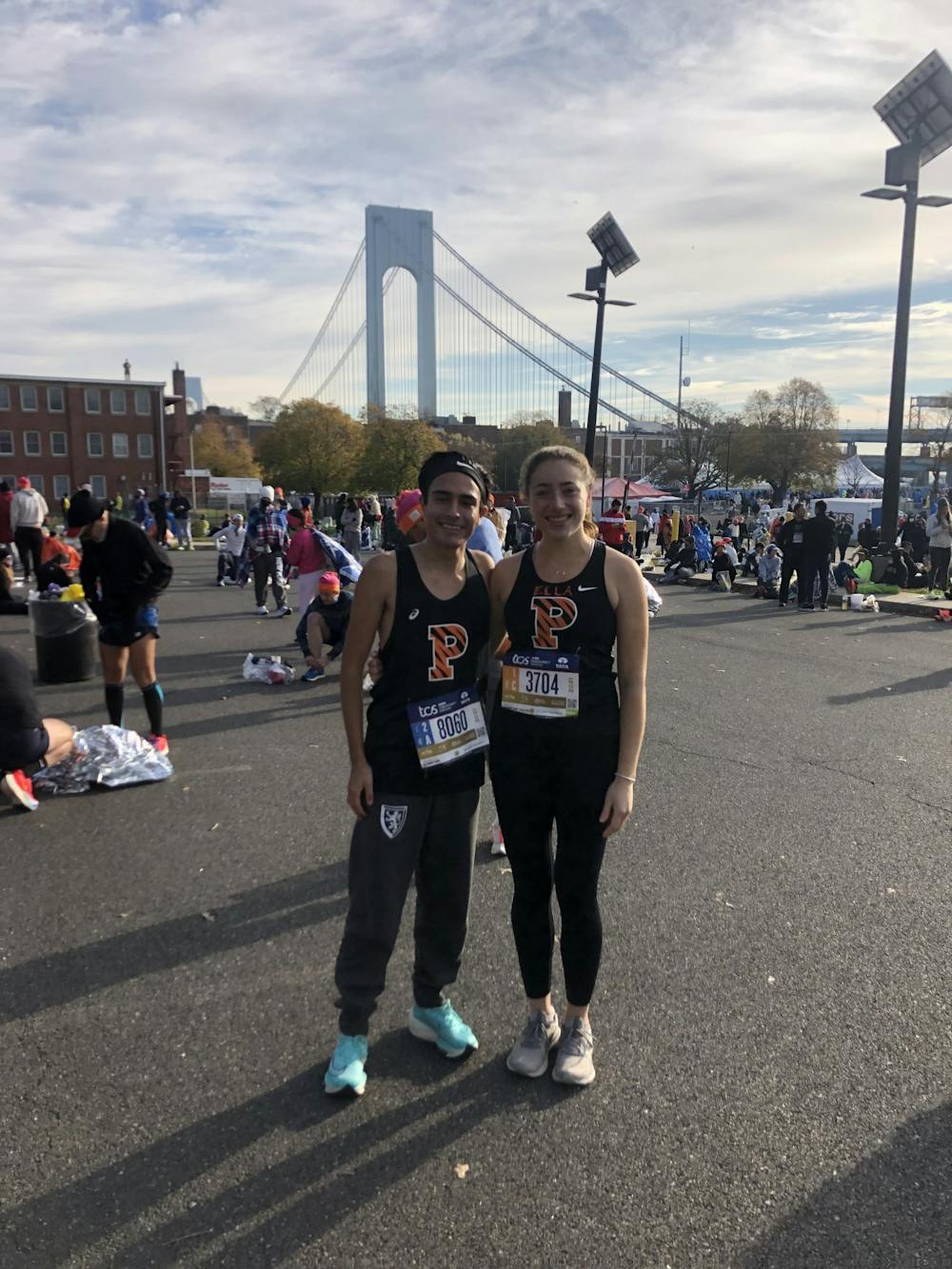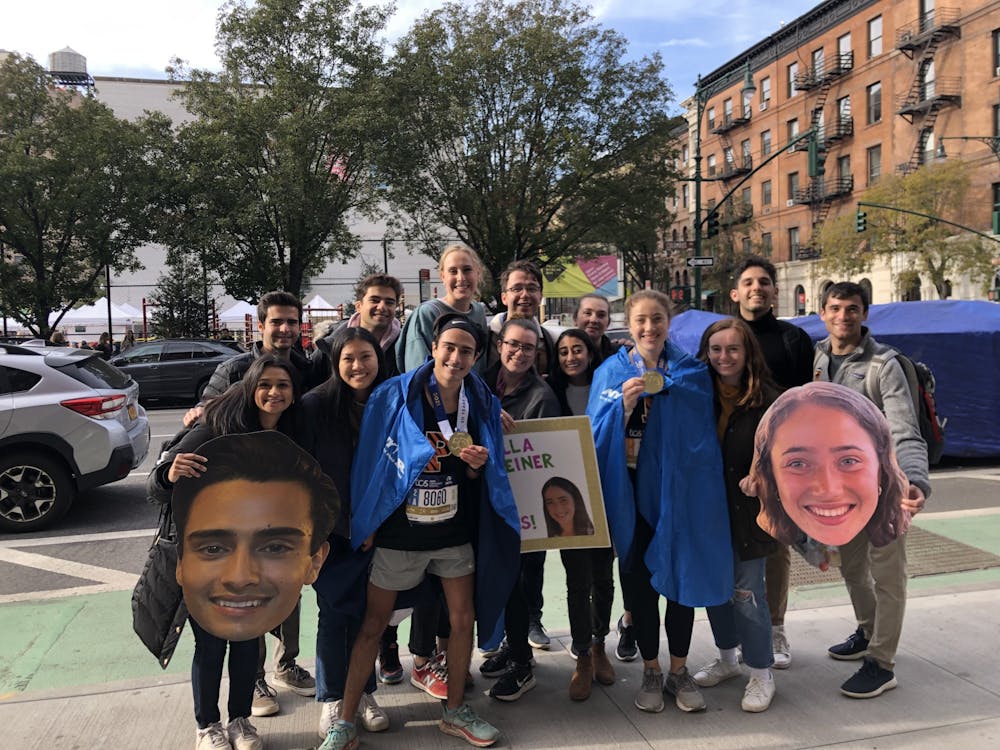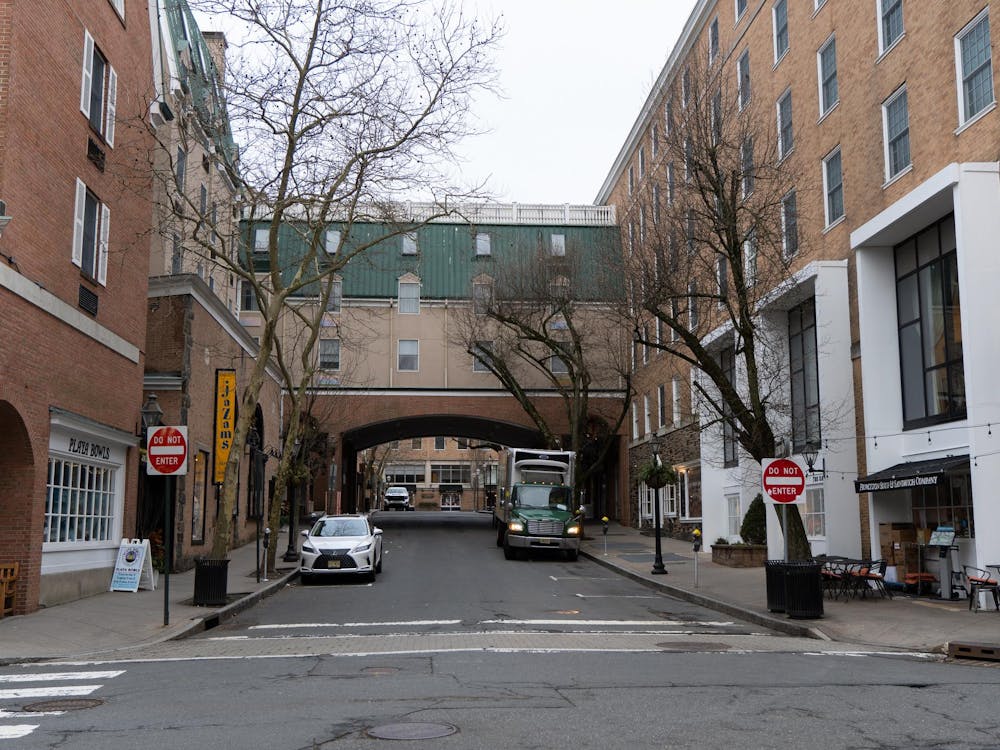In the early hours of Nov. 7, 2021, Ellen Su ’23 walked up to Verrazzano-Narrows Bridge. Music blared in the background, announcers yelled encouragement into microphones. Su remembers taking in those final moments before her run, realizing she was a member of a community of runners all focused on the same goal. Then, to the tune of Frank Sinatra’s “New York, New York,” the race began.
Su is one of a handful of Princeton students who chose to compete in the 2021 New York City Marathon. The largest marathon in the world, this year’s race attracted 33,000 runners, with over a million spectators and thousands of volunteers lining the city streets in support.
The race began in Staten Island, after which participants ran through the other four boroughs of New York City: Brooklyn, Queens, Manhattan, and the Bronx. Finally, runners ended their 26.2 mile journey in Central Park.
“It was just the best four hours ever,” Su said. “The difference between my own 20 mile run on the Princeton towpath and this 26 mile run was crazy. The energy that you can get from the crowds and the runners around you was really amazing.”
For Delaney Callaghan ’23, this wasn’t her first marathon experience, but it was just as special since she had the opportunity to run the race with her father.
“To do it with my dad was really special, because it was something he’s wanted to do for his whole life,” she said.
For Ella Feiner ’22 and Sebastian Quiroga ’22, friends since their first year advising (’zee) group, the race was a culmination of their months-long shared training plan.
The experience was “incredibly emotional,” Quiroga said, “I haven’t really had an experience like that, where you have a million people that are all cheering for you.”

While the four Princeton students had different running backgrounds, gained entry to the marathon in different ways, and dealt with different training setbacks, one thing they share are those few hours of racing — and the months of preparation that went into them.
Training
Neither Feiner nor Quiroga had much running experience before the pandemic. For Feiner, running became an important escape from her house after students were sent home in March 2020.
In the fall 2020 remote semester, Quiroga and Feiner lived together with a group of friends. It was then that Quiroga was inspired by Feiner’s running schedule.

“I think that’s when Ella really started running seriously and I was like, ‘Oh, maybe I should just start running,’” said Quiroga. According to him, the marathon was “not the plan when that started.”
“It was just like, ‘Let’s get out for a little bit,’” Quiroga said.
However, a summer spent working on their senior theses at Princeton led to more runs together and, for Feiner, the desire to complete a marathon. Initially, she proposed to Quiroga that the pair train for the New Jersey marathon in October. However, about a week after this plan was hatched, Feiner returned to Quiroga with a different goal: the New York City Marathon.
Quiroga recalled, “She said, ‘I really think I want to do the New York City Marathon. It’s our senior year. Let’s just send it. It’s my birthday weekend, we’ll make it work.’” He agreed, and the friends turned their sights to November in New York.
Separately, Quiroga and Feiner increased their running volume in preparation for the marathon. In addition to shorter runs on weekdays, long 8 to 10 mile runs on the weekend became 12, then 15, and eventually 20 mile runs.
Su, on the other hand, has wanted to run the marathon ever since she took up running in seventh grade.
“I just absolutely fell in love with [running],” she said. “I can’t even express how happy it makes me. It’s the best place for me to have my thoughts and relieve me of stress.”
Despite the dreaded long runs, Su was prepared for the increased volume — or so she thought.
“I made a very detailed training plan at the beginning of the summer, and then I broke it week one when I got sick,” Su said.
Although Su wasn’t able to stick to her initial plan, she still prioritized the long runs.
“I wanted to get up to 20 miles two weeks before the marathon, so that I knew I could do the distance at least,” she explained.
Much like Su, from July onwards, Callaghan’s priority was making sure she could hit those distances.
“I would do one long run every week,“ she said. “My long runs started at five miles and then they would increase by one mile each week. So I ended up getting all the way up to 20 miles about three weeks before the marathon.”
In order to achieve these distances, the runners relied on many of the well-known routes around Princeton: the towpath, Bean Fields, Herrontown woods, and Pretty Brook. To up their volume even more, Quiroga and Feiner joined the Princeton Running Club, whose long distance runs aligned with their shorter weekly training requirements.
For Feiner, running at night sometimes presented a challenge due to feeling a “little sketched out” while out alone. One solution she devised was to rely on a familiar road: Prospect Avenue. She once ran back and forth along the street for 12 miles to complete her training benchmark.
In addition to grueling long runs, Quiroga cited the nutritional demands of marathon training as another new challenge. Although the marathon itself would have water stations every few miles, in training, he relied on regular sips from a “really stupid looking backpack with a hose.”
Even worse than the unfashionable hydration strategies? The energy gels, filled with necessary sugars and salt to replenish the runners’ bodies during long distance runs. Although she relied on the gels to power her body through 20 mile runs, for Feiner, they were “nausea-inducing.” Quiroga agreed, labeling the gels “really disgusting.”
As the semester wore on, the runners worked to balance their lives as Princeton students with their marathon training schedules. Quiroga and Feiner found that their early morning weekend runs served as additional academic motivation.
“Maybe I’ve just made this up in my head but I feel like after the endorphins you get from long run, it’s really easy to come and sit in a chair and focus on schoolwork for a bit,” Feiner said.
But the balance between studying, training, and sleeping was not always easy to find. For Su, time management presented a big challenge.
“The most important thing I had to plan was my sleep,” Su said.
Particularly the weeks before the race, time management became a pressing concern for Su.
“I had a biochem test the Friday before the marathon, the marathon was on Sunday, and I just had to force myself to go to sleep everyday at like 10 or 11,” she said. “It really stressed me out, because I knew everyone else was studying for so long. But, I also knew that I really wanted [the race] to go well.”
Feiner and Quiroga also adjusted their social lives to match their training schedule. Both stopped drinking alcohol for a month before the marathon, noticing that drinking was affecting their running performance.
Determined to have a fun senior year and not let running get in the way of time with friends, Feiner would regularly go out and not drink.
“I feel like it was a good way to get the best of both worlds,” she said. “Still going to things but leaving a little earlier so [I] could wake up for the 8 a.m. long run.”
Throughout the painful weekend long runs, the “disgusting” energy gels, and the sober nights out, Quiroga and Feiner always had each other to commiserate with.
“It was so nice to have someone on the same training schedule, doing things at the same time,” said Feiner. “Even if we weren’t always running together, I would just want to talk about it all the time … And [my friends] were great, but they did not want to hear about the technical details of how many gels I ate, at what mile, how my stomach felt, what new shoes I’m getting.”
Quiroga also found that training with Ella inspired him to run on days where he might have thrown in the towel. “I’m very sure that there are some runs that I would not have gone on if it weren’t for Ella being like, ‘Come on, you really have to today.’”
Qualifying
Beyond all of the training and sacrifices the runners made for the New York City Marathon, to even receive the opportunity to compete was a hard-fought battle. A runner can gain entry to the marathon by achieving a qualifying time in a different marathon, by entering into a lottery to be randomly selected, or by running for a charity.
For her birthday, Feiner fundraised from family and friends to raise money for Team for Kids, an official charity partner of the New York City Marathon that works to get children without good physical education programs active.
Su’s opportunity to participate came when her friend, Margaret Murphy ’23, began working for Restore NYC, an anti-trafficking nonprofit organization and another marathon charity partner. She raised over $3000 for the organization through social media fundraisers.
Callaghan ran to fundraise for Samaritans, a suicide prevention organization. Throughout high school, she volunteered on the Samaritans hotline. In order to raise money for the organization, she chose to run the Boston Marathon during her senior year of high school. In 2021, she ran for them once again in the New York City Marathon.
“Doing it for something I care a lot about and wanted to raise awareness for just made it so much more powerful for me,” Callaghan said.
Quiroga ran representing a country rather than a charity. After noticing a clause in the qualification guidelines that stated a runner could enter the marathon as a part of an international tour, Quiroga, a dual citizen of Mexico and the United States, began researching whether he could run representing Mexico.
He found that Mexico sent a few hundred runners to compete each year, some of whom hail from his hometown, Monterrey. After emailing the coach and informing her of his interest, Quiroga received an invitation to run with the Mexican team as a non-elite, casual runner.
Race Day
After months of training, the day of the race finally came. That morning, participants woke up at around 4 a.m. to travel to the runners’ village, first by ferry then by bus, before roads closed in preparation for the marathon.
Because runners representing charities had an earlier start time than international runners, Quiroga went to Feiner’s start corral to wish her luck and take a few pictures in their Princeton gear. In addition to celebrating their old friendships, the student runners found the race atmosphere to be filled with friendly strangers.
“Everyone was giving me advice since it was my first marathon,” Su said.

Ella Feiner ’22 and Sebastian Quiroga ’22 posing in their Princeton gear before the race.
Courtesy of Sebastian Quiroga ’22
But amidst free snacks, a beautiful sunrise, and camaraderie, the runners also worked to get their minds marathon-ready.
Callaghan explained the nerves that set in prior to the race’s start.
“I was super anxious, just thinking about what the next four and a half hours would look like,” she said.
Before they knew it, the race began, and the runners were off.
Even with all of their training, the Princetonians did not always find the marathon smooth sailing. Both Quiroga and Feiner considered the Queensboro Bridge, crossing from Queens to Manhattan just before mile 16, to have been the biggest challenge.
“It is so depressing,” Quiroga said. “As soon as you’re approaching this bridge, all the spectators clear out … It’s just silent.”
He continued, “Everyone’s just walking because it’s uphill. You can hear a collective groan of people. You can hear your steps, you can hear your heartbeat. It’s horrifying. And you’re just trying to convince yourself not to start walking.”

Sebastian Quiroga ’22 during the race.
Courtesy of Sebastian Quiroga ’22
Fortunately, after making it through the Queensboro Bridge, the runners arrived on First Avenue in Manhattan to the cheers of one of the biggest crowds in the race.
In these crowds, Quiroga and Feiner were able to spot some familiar faces. Their friends and family had positioned themselves at various points in the marathon and made signs to cheer the pair on.
“That was always in my head as I was running,” Feiner said. “Okay, these people are in two miles. These people are in seven miles. I just have to keep going to them.”
Feiner and Quiroga both wore Princeton shirts, and found that even strangers would shout “Go Tigers” or “Go Princeton” at them as they passed by.
Su found motivation in the other marathon runners.
“During the race, there are a few times where I would look up and see a seventy-year-old running in front of me. If they can do it, I have no excuse,” she said.
“The last five miles really hurt, for sure. But, coming up to Central Park with thousands of people when you have 10 minutes left on this huge thing. I can’t describe that feeling to you,” Su continued.

Ellen Su ’23 during the race.
Courtesy of Ellen Su ’23
According to Feiner, these good feelings didn’t go away after the race was over. She recalled seeing people limping all over the city in blue marathon ponchos.
“Everyone wears their medals all day,” she said. “We would go into places and get free stuff. We got free cookies, and someone bought us free shots.”
In addition to her personal accomplishment, Su explained that one of the unexpected highlights of the marathon was how it encouraged others in her life to consider running.
“A few of my friends are thinking of running the Brooklyn Marathon, or even just a half marathon. They’re inspired by this race,” she said.
As someone who, pre-marathon training, rarely completed runs longer than five miles, Quiroga believes it is “very doable to start as a casual runner and say, ‘I want to do a marathon.’” Quiroga stands as testament to this belief: His time in the New York City Marathon qualified him to compete as an elite runner in the Chicago Marathon.
“I was really afraid, having only done a 5k, and a marathon seems like it’s impossibly different,” Quiroga said. “But as long as you’re building on it, you don’t even notice how it’s getting longer, little by little, and then eventually you’re running 20 miles and you’re like, ‘Wow, I’m here. I can do it.’”
Alex Gjaja is the co-head Features editor for The Daily Princetonian. She can be reached at agjaja@princeton.edu.
Tanvi Nibhanupudi is an Associate Features editor and Chairperson of the Diversity, Equity, Inclusion and Belonging Board at The Daily Princetonian. She can be reached at tanvin@princeton.edu.








